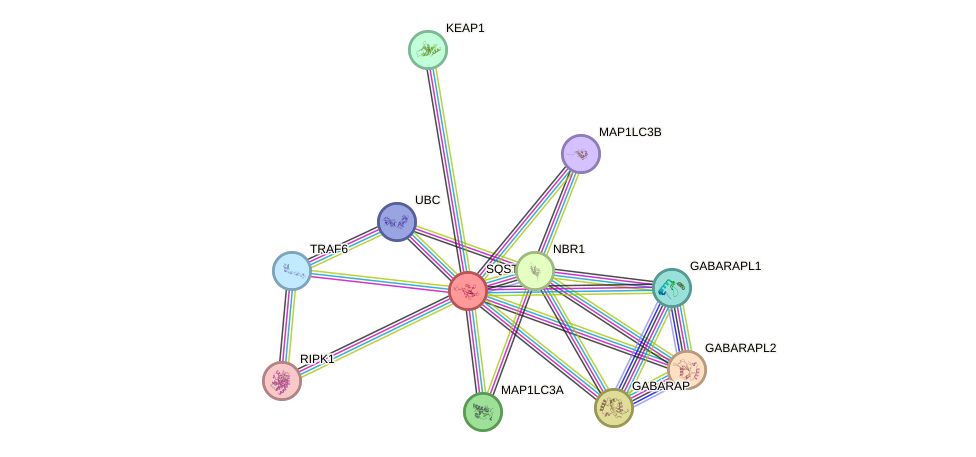GenAge entry for SQSTM1 (Homo sapiens)
Gene name (HAGRID: 298)
- HGNC symbol
- SQSTM1
- Aliases
- p62; p60; p62B; A170; PDB3; OSIL
- Common name
- sequestosome 1
Potential relevance to the human ageing process
- Main reason for selection
- Entry selected based on indirect or inconclusive evidence linking the gene product to ageing in humans or in one or more model systems
- Description
SQSTM1 is involved in autophagic degradation, but possibly apoptosis, immune response and other functions. SQSTM1 knockout mice are short-lived, perhaps due to its role in activating NFE2L2 since tissues exhibited a pro-oxidative environment due to compromised mitochondrial electron transport. Males live 34% less, while females are only slightly shorter-lived. Males also exhibit some signs of accelerated ageing [3261]. While its role in ageing is unproven, SQSTM1 is worthy of further studies.
Cytogenetic information
- Cytogenetic band
- 5q35
- Location
- 179,806,387 bp to 179,838,077 bp
- Orientation
- Plus strand
Protein information
- Gene Ontology
-
Process: GO:0000122; negative regulation of transcription from RNA polymerase II promoter
GO:0000422; mitophagy
GO:0001934; positive regulation of protein phosphorylation
GO:0002376; immune system process
GO:0006468; protein phosphorylation
GO:0006511; ubiquitin-dependent protein catabolic process
GO:0006914; autophagy
GO:0006915; apoptotic process
GO:0006950; response to stress
GO:0008104; protein localization
GO:0010821; regulation of mitochondrion organization
GO:0016197; endosomal transport
GO:0016236; macroautophagy
GO:0016239; positive regulation of macroautophagy
GO:0030154; cell differentiation
GO:0035556; intracellular signal transduction
GO:0043065; positive regulation of apoptotic process
GO:0043066; negative regulation of apoptotic process
GO:0043122; regulation of I-kappaB kinase/NF-kappaB signaling
GO:0044130; negative regulation of growth of symbiont in host
GO:0045944; positive regulation of transcription from RNA polymerase II promoter
GO:0046578; regulation of Ras protein signal transduction
GO:0051291; protein heterooligomerization
GO:0061635; regulation of protein complex stability
GO:0098779; mitophagy in response to mitochondrial depolarization
Cellular component: GO:0000407; pre-autophagosomal structure
GO:0000932; P-body
GO:0005654; nucleoplasm
GO:0005737; cytoplasm
GO:0005770; late endosome
GO:0005776; autophagosome
GO:0005783; endoplasmic reticulum
GO:0005829; cytosol
GO:0016234; inclusion body
GO:0016235; aggresome
GO:0016605; PML body
GO:0044753; amphisome
GO:0044754; autolysosome
GO:0070062; extracellular exosome
GO:0097225; sperm midpiece
Hide GO termsFunction: GO:0004674; protein serine/threonine kinase activity
GO:0005080; protein kinase C binding
GO:0005515; protein binding
GO:0008270; zinc ion binding
GO:0019901; protein kinase binding
GO:0030971; receptor tyrosine kinase binding
GO:0031625; ubiquitin protein ligase binding
GO:0042169; SH2 domain binding
GO:0042802; identical protein binding
GO:0042803; protein homodimerization activity
GO:0043130; ubiquitin binding
GO:0070530; K63-linked polyubiquitin binding
Protein interactions and network
- Protein-protein interacting partners in GenAge
- TP53, STAT5A, NGFR, MYC, INSR, NCOR1, PRKCD, PEX5, HIF1A, BCL2, PML, HTT, FAS, YWHAZ, MAPK14, PIK3R1, CDK1, MAPT, MTOR, MLH1, STUB1, PCK1, NFE2L2, PIK3CA, SQSTM1
- STRING interaction network
Retrieve sequences for SQSTM1
Homologs in model organisms
In other databases
- GenAge model organism genes
- A homolog of this gene for Mus musculus is present as Sqstm1
- GenAge microarray genes
- This gene is present as SQSTM1
Selected references
External links
- EPD
- ORF Accession
- NM_001142298
- CDS Accession
- NP_001135770
- OMIM
- 601530
- HPRD
- 03319
- Ensembl
- SQSTM1
- UniProt/Swiss-Prot
- SQSTM_HUMAN
- GeneCards
- SQSTM1
- Entrez Gene
- 8878
- UniGene
- 724025
- GenAtlas
- SQSTM1
- Internet
- Search Google

